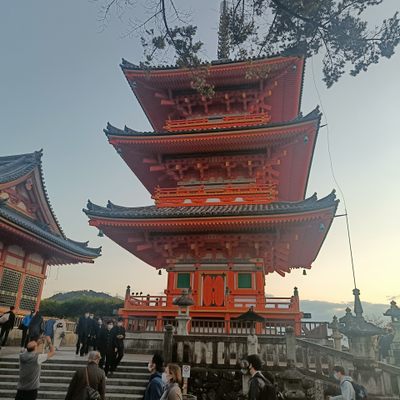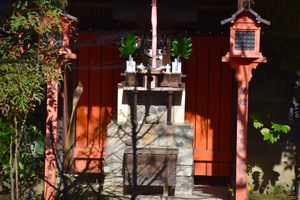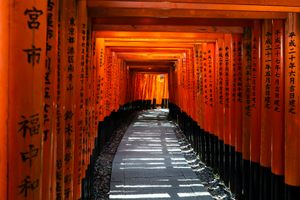About
In a shrine adjacent to the main hall of the Kiyomizu-Dera Temple in Kyoto, nearly 200 small, stone sculptures of the Buddhist deity Jizo wear bibs, placed by grieving parents who have lost children.
Jizo is the protector of unborn children and children who die very young and cannot cross the Sanzu River into the afterlife. It is believed that since they have caused their parents grief by dying so young and they did not live long enough to accrue good deeds, the souls of these children are condemned to having to pile stones by the Sanzu River to help their parents eventually reach the afterlife. They must constantly start over, because the piles are knocked over by demons. Jizo helps the children through this trial, hiding them in his robes when they feel afraid and encouraging them with mantras.
Dressing a Jizo statue is related to dressing a monk statue, a Buddhist tradition that helps one accrue merit for the afterlife. But grieving parents dress the statues of Jizo specifically as a way of thanking him for taking care of their children. They may put hats or robes on Jizo, or anything else, but the most common garment is a bib, like children of earlier times are believed to have worn (the bib can be any color, red is most common because it represents safety).
The Kiyomizu-Dera Temple, a historic monument of ancient Kyoto, was founded 1,200 years ago, and the buildings that can be visited today have stood since 1633 without the benefit of nails. It is a UNESCO World Heritage Site and was a finalist in the New 7 Wonders of the World campaign. An ancient statue of Kannon Bodhisattva, another deity (goddess of mercy), who has 11 faces and 1,00 arms, is put on display at the temple every 33 years.
The Japanese expression that translates to “to jump off the stage at Kiyomizu,” akin to “taking the plunge,” refers to the temple’s stage off the main hall, 43 feet off the ground. Many years ago, jumping off the stage was a way of determining whether or not you would get a wish granted. It is not allowed anymore.
Other attractions at the temple include the Otowa waterfall, over which the temple was built and from which the temple gets its name (which translates to “Pure Water Temple”). The waters are divided into three streams visitors can drink from for different benefits. At the Jishu Shrine, single people try to walk 60 feet between two “love stones” with their eyes closed. If they do so successfully, they will find love; if they do so with help, they will find love with assistance.
The temple itself is an amazing thing to see, as is the view from the stage off the main hall, especially in the spring and fall.
Related Tags
Community Contributors
Added By
Published
May 10, 2017
Sources
- http://www.kiyomizudera.or.jp/en/learn/
- https://en.wikipedia.org/wiki/Kiyomizu-dera
- http://www.japan-guide.com/e/e3901.html
- http://kyoto.travel/en/shrine_temple/131
- http://www.japanvisitor.com/japan-temples-shrines/kiyomizu-temple
- http://www.theworldisabook.com/21517/kiyomizu-dera-kyoto-with-kids/
- http://www.annatrogo.com/2014/08/kiyomizuderazaka-kiyomizudera-asahizaka/
- http://www.japantimes.co.jp/community/2012/03/31/our-lives/a-guide-to-jizo-guardian-of-travelers-and-the-weak/#.WRHS5VLMzqQ
- https://en.wikipedia.org/wiki/Kshitigarbha
- https://books.google.com/books?id=Sd8NCwAAQBAJ&pg=PA65&lpg=PA65&dq=jizo+rescues+souls+of+children&source=bl&ots=BB5ti-Hb_N&sig=-_3mKNYBHzHE6p4BGazsA02Ztsc&hl=en&sa=X&ved=0ahUKEwi72NWFjuPTAhWs5oMKHfWDDy8Q6AEIPjAE#v=onepage&q=jizo%20rescues%20souls%20of%20children&f=false














































